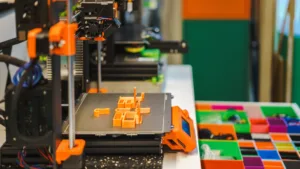How Do Wireless Charger Works ?

Introduction
How do Wireless Charger Works – Wireless charging is becoming increasingly popular with modern phones. Most new phones have some sort of wireless charging option, as do many cases and other accessories. How does wireless charging work? The answer is surprisingly simple: radio waves. In fact, the same principle that allows your cell phone to communicate with cell towers to jam less reliable signals works the same way for wireless chargers.
When you place a battery in an external charger, it creates a resonance between the radio waves produced by the charger and the battery. The electromagnetic field created by the resonance causes the electrons in the battery to flow into the external charger at normal or lower speeds than they would if they were flowing directly from the battery into an electronic device as they normally would. Wireless chargers are also called inductive chargers because they use electromagnetic induction rather than direct current or alternating current to transfer power from one point to another. They work slightly differently than other chargers because they aren’t trying to force power into batteries like DC and AC chargers are; instead, wireless chargers rely on how much energy is available in outside sources such as the sun or wind to charge their batteries when needed.
How Does Wireless Charging Work with Batteries?
Wireless charging uses electromagnetic waves to transport energy from one device to another. When a phone is placed on a wireless charger, it sends a signal to the charger telling it to begin transferring power. The charger then generates radio waves that are absorbed by the phone’s battery and cause the electrons in the battery to move at a different speed.
When the phone is taken off the wireless charger, the wireless signals are absorbed by the phone’s battery and cause the electrons to flow back into the phone. Wireless chargers use electromagnetic waves to transfer energy from one point to another. When a phone is placed on a wireless charger, it sends a signal to the charger telling it to begin transferring power.
The charger then generates radio waves that are absorbed by the phone’s battery and cause the electrons in the battery to move at a different speed. When the phone is taken off the wireless charger, the wireless signals are absorbed by the phone’s battery and cause the electrons to flow back into the phone.

How Does Inductive Charging Work?
Inductive chargers use electromagnetic induction to transfer energy from one point to another. Inductive chargers are slightly less common than their radio frequency counterparts because they don’t work as well with some phones and may be less safe than RF chargers. Inductive chargers emit alternating current and rely on the same electromagnetic principle as generators or power strips.
When the charger is plugged into a wall outlet, it creates an electromagnetic field that attracts metal objects such as your phone. The charger then emits a stronger field, pulling the phone in closer and causing it to charge. Inductive chargers come in many forms, including those that plug into your wall outlet and those that can act as both a wall outlet and a cordless charging pad. Some also have USB ports, allowing you to charge multiple gadgets at once.
How Do Wireless Chargers Work with Radiowaves?
Radiowaves are electromagnetic waves that are easily absorbed by and cause electrons to move within all types of electronic devices, such as phones and computers. Radiowaves are a common form of energy used for wireless charging. Wireless chargers use electromagnetic waves to transfer energy from one point to another. When a phone is placed on a wireless charger, it sends a signal to the charger telling it to begin transferring power. The charger then generates radio waves that are absorbed by the phone’s battery and cause the electrons in the battery to move at a different speed. When the phone is taken off the wireless charger, the wireless signals are absorbed by the phone’s battery and cause the electrons to flow back into the phone.
In a similar way, combined with batteries and electromagnetic waves, radio waves work in a similar way as charged batteries do to transfer energy from one point to another. In the case of wireless chargers, the radiowaves are the source of power.
Why Is Wireless Charging Becoming Popular?
RF wireless charging has been around for almost a decade, so it’s not surprising that most new phones and other devices now come with this technology. The main advantage of RF wireless charging is that it works with almost any phone and other devices, regardless of brand name. In addition, it is nearly silent and doesn’t require the phone to be placed close to the wireless charging pad.
Inductive wireless charging, on the other hand, has been around for much less time. In the last few years, it has received praise from some smartphone manufacturers and the public alike because it works with fewer devices and is less prone to technical issues and safety concerns.
What Are the Benefits of Wireless Chargers?
No wires! These chargers don’t use wires and don’t have to be placed near a power source. They can be placed almost anywhere and are a great option if you don’t have a nearby outlet. – Much Less Likely to Be Ruined by a Short Circuit: With wireless chargers, the risk of fire and electric shock is greatly reduced since the phone would be far away from the charging pad. –
Quick Charge: Some wireless chargers feature Qualcomm Quick Charge technology, providing up to 50 percent charge in just 15 minutes. This is especially helpful if you often find yourself charging your phone overnight while you sleep.
Less Likely to Wear Out Your Battery: Wireless chargers don’t rely on forcing power into batteries as some other types of chargers do. This means that you’re much less likely to wear out your battery, which can be a problem especially if you need your phone for work or other important activities.
Relatively Safe: Compared to other types of chargers, wireless chargers aren’t as hot or dangerous. This is especially beneficial if you have children or pets that might accidentally touch the charger or if you place the charger in a dangerous area.
How Does wireless Charging Affect battery lifespan?
There is a lot of debate surrounding this topic and there is no clear answer as to whether wireless charging is safe or harmful to your phone battery. The main concern is that the electromagnetic fields produced by wireless chargers may be harmful to the phone’s battery.
According to a study conducted by the University of Minnesota, the electromagnetic field produced by a wireless charger is comparable to that produced by a cell phone. While this is much less than the power produced by a cell phone, it is enough to potentially cause harm. The researchers also found that over time, the wireless charger produced electromagnetic radiation that was 2.4 times higher than the radiation that is produced by a typical phone.
Other Wireless Charging Issues
– Bending or breaking wires: Many wireless chargers have exposed wires that can be easily bent or broken. – Signal strength issues: If you’re using a wireless charger on a desk, counter, or table, you may experience signal strength issues.
This is because the signal may be blocked by the device, table, or counter that you’re using. If this is a common issue, you should consider investing in an external wireless charger. – Battery overheating: Some wireless chargers produce excessive heat, which can damage your phone battery. It’s best to use wireless chargers that don’t get too hot, such as those with copper coils, and you should also move the charger away from your phone while it’s charging.
Recommended Wireless Chargers



Also Read: Where to Hide a GPS Tracker on Car

With a degree in Electrical Engineering and years of hands-on experience in the tech industry, passionate to provide readers with insightful reviews. From smartphones and laptops to smart home devices and emerging technologies, he navigates the ever-evolving tech landscape, offering in-depth analyses and honest opinions.








